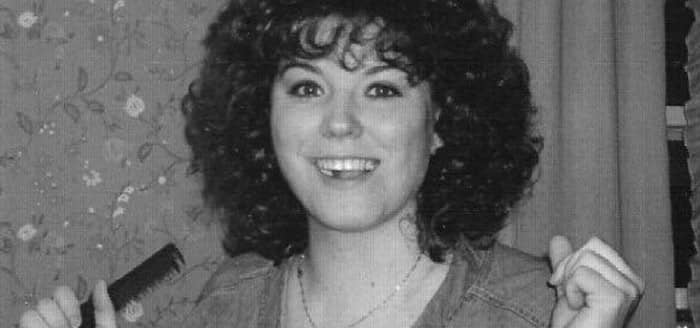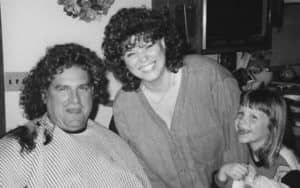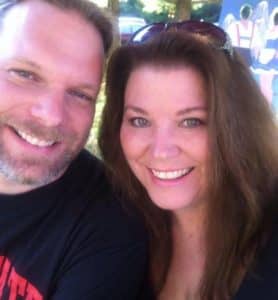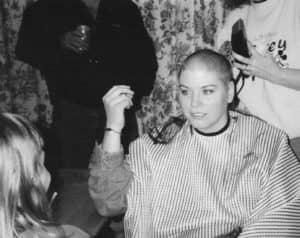How Rose-Tinted Glasses Helped Wendy Holmes Survive Mesothelioma

Wendy Maureen Holmes describes herself as having “a very unique personality type.”
“I live life with a permanent pair of ‘Rose Tinted Glasses,’” Wendy recently told the Mesothelioma + Asbestos Awareness Center. “I openly speak my mind, and I will go to the ends of the earth to help someone in need.”
As a cancer survivor who has spent much of her life working as a volunteer paramedic in a close-knit community, Wendy is perhaps also in a unique position to talk about her experiences with mesothelioma – a rare form of cancer caused by asbestos exposure.
A Shocking Diagnosis
 Any diagnosis of cancer usually comes as a shock. For Wendy, it was even more of a shock than usual, as she didn’t show any symptoms.
Any diagnosis of cancer usually comes as a shock. For Wendy, it was even more of a shock than usual, as she didn’t show any symptoms.
“I was not sick. I was a healthy, active young woman working in the healthcare field with two little girls keeping me very busy.” However, one day she found that her left arm was swollen, caused by what turned out to be a large blood clot in her left subclavian vein – a blood vessel that goes beneath the collarbone (clavicle). “I spent a total of 30 days in the Cleveland Clinic between January and February of 1998,” Wendy recalled. “Over this period of time, blood work showed I tested positive for cancer. The levels were off the charts.”
The most amazing part was how far the cancer had progressed. It is rare for late-stage tumors to develop without any symptoms at all, but as it turned out, Wendy had stage 4 mesothelioma.
“A CT scan was ordered to better show what on earth was going on,” Wendy described the diagnostic tests that were used. “My body was loaded full of tumors, which were my lymph nodes from my neck to my groin. I had some pleural thickening and my abdomen was fluid filled within my peritoneal cavity. All cancer.”
Doctors removed a lymph node from Wendy’s neck for testing. She was tested for a variety of different cancers, including breast cancer, colon cancer, ovarian cancer, and others. “I was tested for it all,” she said, but everything came back negative.
In March 1998, Wendy returned to the Cleveland Clinic to learn her fate. “After the Cleveland Clinic got the results, it did not connect with a person of my age bracket and sex,” she explained, considering that most people who are diagnosed with mesothelioma are men in their sixties or older. “My slides and blocks were sent to Boston for a second opinion, which were sent to Europe for a third opinion.”
These opinions all lead to the same conclusion, however, and the prognosis was extremely dire. “Due to my presentation and severity, I was diagnosed with end-stage (Stage 4) mesothelioma and given 12-18 months to live if I used chemotherapy to buy me some time and make my death process less painful.”
“Imagine hearing this load of news when you are sitting there, not ill, not tired, and not prepared for such a statement.”
At the urging of her mother, Wendy got a second opinion through The James Cancer Hospital at Ohio State University. They also confirmed the diagnosis and prognosis. “I met with an oncologist who was a bit surprised I chose The James over the Cleveland Clinic. My choice had nothing to do with statistics and merit. I chose the person who allowed me to have hope, even if it was only measured at a 1 percent chance of survival.”
Hope in a Frightening Time
As it turned out, Wendy was able to find hope in a number of places, and she attributes that to her long-term survival. “There were many people in my life that were my rock in their own unique ways.”
Wendy’s mother, Darlene Phillips, offered hope through her constant and unwavering help. “Her only outlet of being a fighter was her own education and persistence,” Wendy remembered. “She was the one who was behind the scenes making phone calls, bugging specialists, keeping a journal, making arrangements and pushing me in every direction she felt was important to save my life…. She is the only woman I know who can suck it up and stay in charge for the sake of the task at hand.”
Not that it was always easy, Wendy acknowledged. “I know she cried as much as I did. Maybe more. There were times I wished she would just quit and let me spend my remaining months trying to be okay with death. It was those times I needed her the most and just never knew it.”
Where her mother helped out with supporting Wendy physically and organizationally, her father helped Wendy by providing spiritual and emotional guidance. “He was many things, but he was also an ordained minister who helped me better understand my relationship with my God. I am not a ‘churchy’ person and he accepted and respected that. He never browbeat me with religion, but helped me grasp that love conquers all,” Wendy explained of her relationship with her father. “Love heals hearts, bodies, souls and fears.”
“My particular God doesn’t reside in a temple, but inside of me as my best friend. I am surrounded with others from the other side that also love and protect me, as well as prepare me for life-situations. I embrace them all daily.”
 Another person who offered Wendy hope during her struggle with mesothelioma was Calvin, her best friend and the one who encouraged her to become a paramedic in the first place. “He was my confidant, my rock, and that person who could just sit next to you in silence that didn’t even have to ask how you were that day,” Wendy said of their relationship. “He knew me inside and out. He accepted me for that quirky person I truly was.” The things Calvin did for her didn’t stop with their job, however. “He talked to me every single day. He took my kids for ice cream so I could sleep. He sang to me. He made me laugh on the worst days. He was in constant contact with my mom, backing her in all her efforts.
Another person who offered Wendy hope during her struggle with mesothelioma was Calvin, her best friend and the one who encouraged her to become a paramedic in the first place. “He was my confidant, my rock, and that person who could just sit next to you in silence that didn’t even have to ask how you were that day,” Wendy said of their relationship. “He knew me inside and out. He accepted me for that quirky person I truly was.” The things Calvin did for her didn’t stop with their job, however. “He talked to me every single day. He took my kids for ice cream so I could sleep. He sang to me. He made me laugh on the worst days. He was in constant contact with my mom, backing her in all her efforts.
Calvin and Wendy were married in 2002, and sadly, he died five weeks later. “He asked God to take him so I could live,” Wendy reminisced about that time in her life. “I never knew you could be loved like that. We all know God doesn’t make deals like this, but the compassion and desire to see me survive was in his every breath.”
Through each of these people, Wendy found the strength to handle the shock of her diagnosis and fight back against the mesothelioma tumors that had invaded her entire body.
Learning About an Unknown Disease
Wendy had never heard of mesothelioma before her diagnosis. “Very few commercials were on the TV back then,” she explained. “We purchased a computer for the sole purpose to find anything we could learn about asbestos.”
Even worse, everything she found out about the rare form of cancer was full of doom and gloom. “All the medical professionals in my circle who have heard of this disease would give me the same look when I filled them in on my diagnosis. That look was out loud fear, because no one survives.”
Wendy underwent three rounds of chemotherapy to try to fight the disease. However, by December 1998, about nine months after her diagnosis, things had not progressed well. “I met with my oncologist knowing I would stop all chemotherapies and choose palliative care,” she said. “I had done three rounds of treatment with zero improvement according to each CT scan result. I was scared to have this discussion with him, but I had to face reality.”
When she sat down face-to-face with her doctor, Wendy knew something was different this time around. “He sat next to me, held my hand and said he needed to talk to me. I mentally prepared myself for ‘the talk’ and took a deep breath. He told me that my last CT was different.”
Wendy expected the worst. But she was in for yet even more unexpected news.
“All tumors were gone,” she learned from her doctor. “My labs showed zero sign of cancer. My body was 100% clean, outside of a small scarring in my pleural cavity. I was CANCER FREE!”
In the shock of the moment, Wendy was unable to speak. “I don’t remember much after that. I was in complete shock. He had his nursing staff come in and hear the news. Everyone had tears of happiness and confusion…. I am still in awe.”
Wendy attributes her unexpected recovery to the use of holistic remedies that the had taken alongside her chemotherapy treatments. “I was given the green light to dive into holistic ways by my oncologist,” she told MAA Center. “It wasn’t going to harm anything because there was no getting out alive as far as science was concerned. His only request was that I backed off any dosages that could interfere with chemotherapy a few days before and after my treatments.”
The go-ahead to look for ways to help her own body heal gave Wendy a purpose, and she dove into the project head first. “I researched and devised a flow chart of my new daily regimen. I learned about Guided Imagery and practiced it daily.” She also used meditation and brain training to remove her fear and focus on positive energy. “Dark days always managed to creep in, but they didn’t last for long. I allowed myself to embrace all emotions and learn from them.”
The effect of her holistic approach to her cancer treatment helped Wendy in immeasurable ways. “I never was sick from this disease. I never felt bad, never had shortness of breath. I had glowing skin and my nurses were shocked at how well I was with they types of chemotherapy I was given. I attribute that to my holistic approach.”
Wendy’s experience with holistic remedies went on to help others as well “(My oncologist) knew my holistic remedies were a proven bonus, as he was referring my regime to some of his other patients. To be loaded full of cancer one day and none the next is just hard to wrap your head around. A second scan was performed to prove there was no error on equipment. Zero cancer!”
Helping Others and Banning Asbestos
Wendy is one of the longest survivors of mesothelioma still alive, and she is intent on helping others through this and other forms of cancer. At the end of this summer, she will have a certification in holistic healing, and she wants to find other ways to help those in need as well.
“My hope is to work with cancer patients, people needing to find that one person (me) who can be their cheerleader in this rat race and teach them what I have learned,” she insisted. “Life is terminal. Life also is a beautiful journey of the unknown, and finding our own way, learning how to embrace the good with the bad in harmony. I know how blessed I am to be here today and I try hard not to take it for granted.”
Part of that help is to make sure people are aware of the dangers posed by asbestos. As for her own situation, she does not know specifically how she was exposed – because she was exposed in so many different ways.
“My mother and myself performed many family interviews,” Wendy described of her search to learn how she came into contact with asbestos. “Come to find out, I was exposed to asbestos everywhere I spent time. My father’s clothing was the primary source. He was a lifelong mechanic. The black grit on his shirts was asbestos from brake pads and clutches. Gaskets contained asbestos as well. The floor tiles in our kitchen, the clothes dryer, hair dryer, schools, exterior house shingles, roof shingles… all contained asbestos.”
Now, she wants to make sure others are aware of the harm that asbestos can do. “As far as asbestos is concerned, please educate yourself! This stuff is still around us. Flipping a home? Have it tested before you tear anything down. Work in a factory? Ask and demand the knowledge of whether asbestos is in that facility. Bring awareness to others around you about this topic. Shove it in their faces if need be! Vote only for those who are all for banning asbestos in the United States. Use your voice! This disease has no conscience. It feeds on our souls.”
